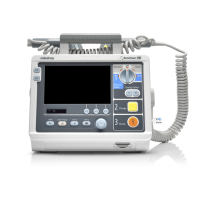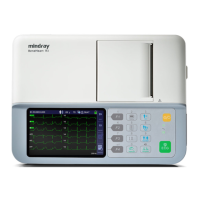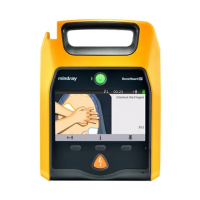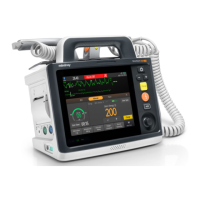Do you have a question about the Mindray BeneHeart C Series and is the answer not in the manual?
Provides critical safety instructions and warnings for operating the equipment.
Highlights imminent hazards that can cause death or serious injury.
Alerts to potential hazards or unsafe practices that could cause death or serious injury.
Warns about potential hazards leading to minor injury or product damage.
Specifies the intended application and user training for the BeneHeart defibrillator.
Provides essential safety precautions before installing and using the equipment.
Outlines the steps for installing the BeneHeart AED equipment.
Guides users on how to unpack and inspect the equipment and accessories.
Specifies the necessary environmental conditions for operating the AED.
Instructs on how to properly connect the electrode pads to the AED.
Details the procedure for powering on the AED unit.
Provides instructions on how to safely power off the AED unit.
Crucial safety guidelines and warnings for operating the AED during a rescue.
Outlines the step-by-step procedure for responding to a cardiac arrest emergency.
Details how the equipment enters and functions during CPR status.
Explains the use of the CPR metronome for guidance on compression and ventilation.
Guides on connecting and using the CPR sensor for feedback.
Crucial safety guidelines for handling, using, and storing the battery.
Step-by-step guide on how to replace the battery in the equipment.
Detailed procedures and recommended agents for cleaning the equipment.
Critical safety warnings related to performing maintenance on the equipment.
Outlines recommended tests and their frequencies for ensuring readiness.
Guides on performing user tests to verify equipment installation and function.
Lists standards, modes, waveform, energy, and impedance for defibrillation.
Details electromagnetic compatibility requirements and guidance for the equipment.
Details default settings for shock series, energy levels, and CPR modes.
Voice prompts and descriptions for guiding CPR procedures.
Provides critical safety instructions and warnings for operating the equipment.
Highlights imminent hazards that can cause death or serious injury.
Alerts to potential hazards or unsafe practices that could cause death or serious injury.
Warns about potential hazards leading to minor injury or product damage.
Specifies the intended application and user training for the BeneHeart defibrillator.
Provides essential safety precautions before installing and using the equipment.
Outlines the steps for installing the BeneHeart AED equipment.
Guides users on how to unpack and inspect the equipment and accessories.
Specifies the necessary environmental conditions for operating the AED.
Instructs on how to properly connect the electrode pads to the AED.
Details the procedure for powering on the AED unit.
Provides instructions on how to safely power off the AED unit.
Crucial safety guidelines and warnings for operating the AED during a rescue.
Outlines the step-by-step procedure for responding to a cardiac arrest emergency.
Details how the equipment enters and functions during CPR status.
Explains the use of the CPR metronome for guidance on compression and ventilation.
Guides on connecting and using the CPR sensor for feedback.
Crucial safety guidelines for handling, using, and storing the battery.
Step-by-step guide on how to replace the battery in the equipment.
Detailed procedures and recommended agents for cleaning the equipment.
Critical safety warnings related to performing maintenance on the equipment.
Outlines recommended tests and their frequencies for ensuring readiness.
Guides on performing user tests to verify equipment installation and function.
Lists standards, modes, waveform, energy, and impedance for defibrillation.
Details electromagnetic compatibility requirements and guidance for the equipment.
Details default settings for shock series, energy levels, and CPR modes.
Voice prompts and descriptions for guiding CPR procedures.
| Device Type | Automated External Defibrillator (AED) |
|---|---|
| Voice Prompts | Yes |
| IP Rating | IP55 |
| Display | Color LCD screen |
| Waveform | Biphasic Truncated Exponential (BTE) |
| Energy Levels (Adult) | 200J |
| Energy Levels (Child) | 50J |
| CPR Guidance | Real-time feedback |
| Self-Tests | Daily, Weekly, Monthly |
| Data Transmission | USB |
| Operating Temperature | 0°C to 50°C |
| ECG Monitoring | No |
| SpO2 Monitoring | No |
| NIBP Monitoring | No |
| EtCO2 Monitoring | No |
| Temperature Monitoring | No |
| Connectivity | Bluetooth or USB (depending on the model) |












